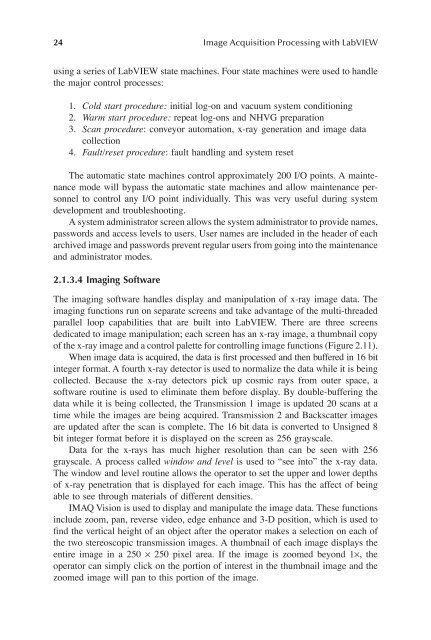Image Acquisitionand Proces
You also want an ePaper? Increase the reach of your titles
YUMPU automatically turns print PDFs into web optimized ePapers that Google loves.
24 <strong>Image</strong> Acquisition <strong>Proces</strong>sing with LabVIEW<br />
using a series of LabVIEW state machines. Four state machines were used to handle<br />
the major control processes:<br />
1. Cold start procedure: initial log-on and vacuum system conditioning<br />
2. Warm start procedure: repeat log-ons and NHVG preparation<br />
3. Scan procedure: conveyor automation, x-ray generation and image data<br />
collection<br />
4. Fault/reset procedure: fault handling and system reset<br />
The automatic state machines control approximately 200 I/O points. A maintenance<br />
mode will bypass the automatic state machines and allow maintenance personnel<br />
to control any I/O point individually. This was very useful during system<br />
development and troubleshooting.<br />
A system administrator screen allows the system administrator to provide names,<br />
passwords and access levels to users. User names are included in the header of each<br />
archived image and passwords prevent regular users from going into the maintenance<br />
and administrator modes.<br />
2.1.3.4 Imaging Software<br />
The imaging software handles display and manipulation of x-ray image data. The<br />
imaging functions run on separate screens and take advantage of the multi-threaded<br />
parallel loop capabilities that are built into LabVIEW. There are three screens<br />
dedicated to image manipulation; each screen has an x-ray image, a thumbnail copy<br />
of the x-ray image and a control palette for controlling image functions (Figure 2.11).<br />
When image data is acquired, the data is Þrst processed and then buffered in 16 bit<br />
integer format. A fourth x-ray detector is used to normalize the data while it is being<br />
collected. Because the x-ray detectors pick up cosmic rays from outer space, a<br />
software routine is used to eliminate them before display. By double-buffering the<br />
data while it is being collected, the Transmission 1 image is updated 20 scans at a<br />
time while the images are being acquired. Transmission 2 and Backscatter images<br />
are updated after the scan is complete. The 16 bit data is converted to Unsigned 8<br />
bit integer format before it is displayed on the screen as 256 grayscale.<br />
Data for the x-rays has much higher resolution than can be seen with 256<br />
grayscale. A process called window and level is used to “see into” the x-ray data.<br />
The window and level routine allows the operator to set the upper and lower depths<br />
of x-ray penetration that is displayed for each image. This has the affect of being<br />
able to see through materials of different densities.<br />
IMAQ Vision is used to display and manipulate the image data. These functions<br />
include zoom, pan, reverse video, edge enhance and 3-D position, which is used to<br />
Þnd the vertical height of an object after the operator makes a selection on each of<br />
the two stereoscopic transmission images. A thumbnail of each image displays the<br />
entire image in a 250 ¥ 250 pixel area. If the image is zoomed beyond 1¥, the<br />
operator can simply click on the portion of interest in the thumbnail image and the<br />
zoomed image will pan to this portion of the image.



